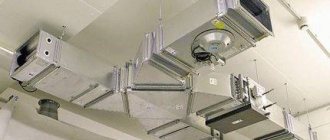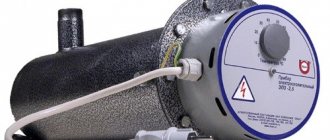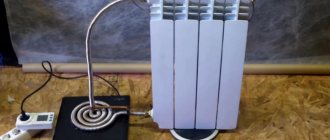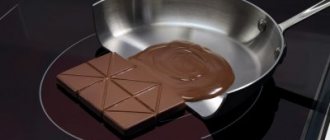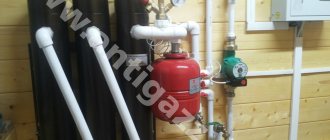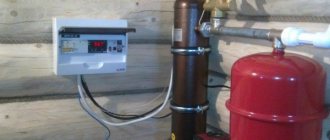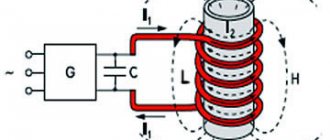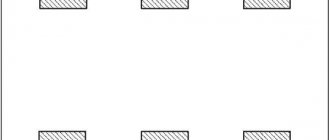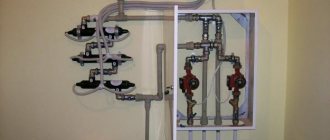Induction heating is a method of non-contact heat treatment of metals capable of conducting electrical energy under the influence of high-frequency currents. Induction heating has become increasingly used in enterprises for high-temperature processing of metals. Today, induction equipment has been able to take a leading position, displacing alternative heating methods.
Working principle of induction heater
The main element of an induction heater is a spiral part.
When an alternating electric current flows through the inductor spiral, an electromagnetic field is formed around it. When a metal core with magnetic properties is placed in the middle of the coil, its temperature rises. This is induction heating - a phenomenon that occurs under the influence of eddy currents. It is observed only when the inductor is powered by an alternating electric current that has a sufficient frequency of changes in sign and direction. When a direct current is applied to the inductive part, there is no change in core temperature.
The operation of an inductor for heating workpieces is based on this principle. The main component of the unit in most cases is a spiral configuration made of metal. In cooking stoves, this role is played by a flattened element located at a short distance from the hob. In a heating boiler, the role of an inductor is played by a steel tube filled with coolant (its function is performed by liquid).
The important components of the unit in question are the alternator and heating element. The first is used to obtain sufficiently high frequency power from a typical residential electrical network of 50 Hz. The second is a metal structure capable of absorbing heat when located in a field space. The generator directs an electric current adjusted to the required parameters to the inductor (spiral element). In this case, a stream of charged particles passes through the coil, creating a field. The metal placed in its action zone is heated under the influence of Fouquet currents without direct contact with the inductor. To heat water in such a unit, it must be in contact with the heating element. The simplest example of such a design would be a metal pipe through which water flows. In the process, the liquid cools the walls, which extends the life of the structure.
Historical reminders to note
The noted melting technique is used in industry, medicine, and the domestic sphere, due to the pronounced advantages compared to traditional heating methods:
- resistive,
- fiery,
- stove and others.
Induction heating is especially useful for high-precision or repetitive applications.
Induction heating was first used by Michael Faraday, a physicist and chemist from Great Britain. The scientist discovered a unique heating property while studying the induction of currents in wires under the influence of a magnet.
However, the basic principles of induction heating were presented a little later by James Maxwell in a unified theory of electromagnetism. At the same time, James P. Joule was the first to describe the heating effect of current flowing through a conductive material.
In 1887, Sebastian Ziani de Ferranti proposed induction heating as a method for melting metals. The first fully functional induction furnace was built and introduced to the public (1891) by F. A. Kjellin. The first application of a high-frequency furnace was realized by Edwin F. Northrup (1916).
The development of solid-state oscillators using new power semiconductor technologies has provided potential beyond the industrial environment. Since the late 1980s, various proposals for use have appeared.
In recent years, there has been particular interest in induction heating for medical procedures, since this method provides accurate and targeted local heating.
Advantages and disadvantages of the device
The liquid can be machine oil or antifreeze.
Induction heating can provide a number of benefits that the use of electrode devices cannot provide. Since the liquid is heated by a metal element that does not take part in electrochemical reactions, the durability of the device depends only on the coil. The duration of its operation is determined by the duration of operation of the device. Some inductors remain operational for more than 10 years. This also relates to the compatibility of the unit with different types of coolant fluids. In addition to plain water, machine oils and antifreeze compounds are suitable for this role.
The internal parts of the unit are not covered with scale deposits during use. Due to constant contact with liquid, the likelihood of parts overheating is reduced, which also helps to extend the service life. Convection in the device usually reaches a sufficient level that it is not necessary to install a circulation pump. There is no need for soundproofing measures - the device operates quite quietly.
For an emergency shutdown of a homemade device, a temperature sensor is required.
However, the induction heater also has its weaknesses:
- The device requires electrical energy to operate. In a room where there is no electricity or where it is not possible to provide access to it, the boiler will not be able to operate. In places with regular network outages, it will not work effectively.
- When the temperature rises excessively, the heat-transferring liquid turns into a gaseous state. This provokes a strong increase in pressure in the structure, which can result in pipe rupture. To prevent this from happening, it will be necessary to equip the installation with means of monitoring pressure and temperature. This could be a pressure gauge, a temperature sensor, or a device for emergency shutdown when the parameters go beyond the specified range.
The need for additional equipment can contribute to a significant increase in the cost of equipment for a homemade induction heater.
The device is considered almost completely silent, but in practice this is not always the case. This applies to industrial production models and home-designed installations.
Heating adjustment
The core of an induction soldering iron is made of copper (not a magnetic material), and the back of it is coated with a ferromagnetic material (an alloy of iron and nickel). The front part serves as a sting, the core itself is called a cartridge.
The heating of the copper tip is adjusted as follows:
- when an alternating voltage, and therefore a field, is applied, Foucault currents are generated in the coating, which heat the material;
- heat is transferred to copper;
- as soon as the coating temperature reaches the Curie point, the magnetic properties disappear and heating stops;
- during operation with an induction soldering iron, the copper tip transfers heat to the part and cools, and the ferromagnetic coating also cools;
- as soon as the coating cools, the magnetic properties return and heating immediately resumes.
The maximum heating of an induction soldering iron depends on the properties of the magnetic alloy and core. This control is called smart heat.
You can change the temperature for specific soldering conditions by installing a temperature sensor that is connected to the station control unit, or by changing the cartridges (core with tip) that are inserted into the handle of the induction soldering iron.
The first option is cheaper than the second, so today it is used not only by professionals. But the second method is more accurate and reliable.
Homemade device options
There are several ways to make a heater at home. The most affordable option is to make the device from an electric kitchen stove and polypropylene pipe. The inverter device is complex to implement, but quite powerful.
Pipe heating element
The induction cooker must be disassembled to construct the heater.
This development involves dismantling the spiral inductor installed in the electric cooker and placing a new design in its place. To make it, you will need a polypropylene tube 0.5 m long and 4 cm in diameter, a magnetic element, 5 textolite rods, and bends for connecting to the heating network. You will also need to purchase a coil of conductor with a diameter area of 2 mm² coated with glass insulation (such a cable is often used in transformer welding devices) and metal scourers for washing dishes.
Sequence of actions in the manufacture of the device:
- A magnet is placed in the tube and filled with washcloths (chopped wire can be used instead).
- Mount branches equipped with threads.
- Rods are glued along the body, onto which a wire coated with glass insulation is wound.
- The hob is disassembled and the factory inductor, made in the form of a flat spiral, is removed from it. A prepared structure is installed in its place.
The heater in this device is metal sponges placed in the alternating field of the coil. When the panel is started in maximum mode while passing water in parallel, it will heat up by 15-20 °C. Considering that the tiles used for the construction usually have a power of no more than 2000 W, the resulting unit is suitable for heating residential premises up to 25 m².
The efficiency of the device can be increased by connecting it to a welding machine, but such work is associated with a number of difficulties. Firstly, you will need to disassemble the device and look for places on the diagram that have not yet been straightened. This is due to the fact that a direct current is created in it, and an alternating current is required for the heater to function. Secondly, you will need to use thicker wiring (for example, copper with a diameter of 1.5 mm, coated with enamel) and calculate the required number of turns. Finally, it will be necessary to implement a cooling mechanism into the installation.
Assembling an induction boiler
The principle of operation of an induction boiler for heating
This solution does not involve disassembling the tiles. Instead, the craftsman will need to weld the boiler tank according to its dimensions. Take a profile tube made of steel 2 mm thick and the hole dimensions are 2 by 4 cm. From it you will need to make blank elements along the width of the panel. The pipes are welded along their length, aligning their smaller sides. Iron tires must be hermetically welded up and down to the end parts. Holes are made in them and threaded pipes are installed. You also need to weld a couple of corners that form a shelf for the stove.
The device must be painted with a temperature-resistant enamel composition. After it has dried and secured, the boiler is mounted on the wall and embedded into the heating system. The hob is placed in a nest with corners and connected to the electrical network. Then you need to fill the installation with coolant, bleed off the air masses and start heating the inductor element.
A homemade heater is not powerful enough to heat large living spaces. In frosty winter it will be able to heat two small rooms. During transition seasons, when the air temperature outside is around zero, the unit will be able to serve large areas - up to 40 m2.
From a welding inverter
If you intend to use a welding machine, you must take into account that connecting the inductor directly to its terminals is strictly prohibited. Violation of this requirement is fraught with loss of functionality of all elements of the installation. To combine an inductive heater with a welding machine, the latter will have to carry out a number of complex manipulations that require the experience of a craftsman and a detailed understanding of the structure of the unit. The primary winding must be connected after the high-frequency signal converter of the inverter mechanism instead of its built-in inductive choke. In addition, it is necessary to solder the condensation unit and dismantle the diode bridge.
How to make a powerful induction heater
Powerful induction heater with power supply
The devices considered have a power consumption of around 2.5 kW. To make a device with a higher rating (4 kW), the master needs serious knowledge in the field of radio electronics. It is not safe for an inexperienced radio amateur to undertake this work.
One option could be a design consisting of a power supply with two pairs of windings, a transformer, driver and control boards. The frequency at which the unit operates is inferior to the resonant one. Two coils are used to supply the drivers, one is for the control board, and one more is the power coil. It powers the starter relay, fan and coolant pump.
Evaluation of marketing characteristics-statements
Many advantages are attributed to induction heating boilers, often without argument. Let us list these characteristics and evaluate the degree of correspondence of the statements to the fact:
Economical
Electricity consumption by induction boilers is 20-30% less than other electric heaters.
Fact
All heating electrical devices that do not perform mechanical work convert 100% of the energy of electric current into heat; their efficiency is always below 100%, but differs in value for different devices under different conditions. To generate 1 kW of thermal energy, it is necessary to consume more than 1 kW of electricity, but how much more depends on the parameters of the dissipation medium. Inside the boiler, of course, there are also losses - for example, for heating the coil, since any conductor material has resistance, but all these losses remain indoors
Perhaps this fact explains the statement about the efficiency of induction boilers.
Durability
High reliability and long service life of the equipment - more than 25 years.
Fact
Indeed, the absence of moving parts eliminates mechanical wear of induction boilers. But the heating system with a VIN unit includes a circulation pump, the resource of which is much more modest. In addition, the control and automation system includes mechanisms that also consist of many components that are subject to wear.
The core of an induction heater operates under conditions of constant cyclic heating and cooling, temperature deformations, which are also a negative factor. Therefore, calling the resource of induction boilers almost limitless is an exaggeration. However, it is indeed several times higher than heating element heaters.
Consistency of characteristics over the entire service life
The absence of scale formation on the inner surface of the pipes ensures the constant efficiency of the heater and heat exchanger.
Fact
Scale is the deposition of salts contained in water (coolant). The amount of these impurities in a limited volume of coolant is also limited and small, so the effect of scale on the efficiency of the heater is insignificant. And in an induction boiler, the secondary winding is under almost constant vibration, and scale formation does not occur at all. So the statement is correct, only its significance is exaggerated.
Silence
The operation of induction heating boilers is silent, which distinguishes them from other electric heaters.
Fact
The statement is true, but all electric boilers do not make noise during operation, since acoustic waves are not included in their oscillation range. Only the circulation pump can make noise, but if you wish, you can choose a silent model.
Compactness
Induction boilers are compact, which is convenient when choosing their installation location.
Fact
This is true if you do not use a cascade of induction boilers and do not install intermediate tanks if there are several hot water intake points in the hot water supply system, since an induction heater is, by and large, a small piece of pipe with a winding.
Fact
There are no absolutely safe electric heaters. When operating induction devices, the possibility of coolant leakage from the system cannot be ruled out, and the electromagnetic field generator will continue to operate, and the system of empty pipes will heat up. To prevent the occurrence of such a situation, the boiler design provides an automatic shutdown device, but it can also fail.
Therefore, induction heaters, while outperforming their competitors in some safety criteria, are not completely safe.
Safety Tips
Installations of this type are widely used not only for space heating, but also for smelting operations. The main problem with home-made induction devices is the lack of components that provide temperature and pressure control and explosion protection. Therefore, when operating such units, care and caution must be exercised.
Before starting the induction boiler, it is necessary to fill the system with coolant
Before starting the boiler, check that the cavity is filled with coolant. A case made of polymers will begin to melt without regular cooling with liquid. This entails deformation changes and complete failure of the installation. Also dangerous can be the fall of hot metal from the melting body. In the event of such an incident, it will be necessary to replace a number of installation components.
The device is connected to electricity through a separate wire, which is led from the switchboard. The contacts must be covered with insulating material. If the design involves a welding machine, its inverter must be grounded. The wire used for this operation should be 4-6 mm in diameter. To prevent excessive heating of the installation in the absence of water, it is advisable to install an excess pressure valve in the inlet.
Working diagram
The heater includes the following components:
- An inverter unit designed for a voltage of 220…240 V, with a current of at least 10 A.
- Three-wire cable line (one wire is ground) with a normally open switch.
- Water cooling system (it is highly advisable to use water purification filters).
- A set of coils that differ in internal diameters and lengths (for limited volumes of work, you can get by with one coil).
- Heating block (you can use a module with power transistors produced by Chinese companies Infineon or IGBT).
- Damper circuit with several Semikron capacitors.
The high-frequency oscillation generator is the same as that of the base inverter. It is important that its operational characteristics fully comply with those indicated in the previous sections.
After assembly, the unit is grounded and the heating induction coil is connected to the inverter power supply using connecting cables.
Approximate operational capabilities of a homemade metal induction heater:
- Highest heating temperature, °C – 800.
- The minimum power of the inverter is 2 kVA.
- PV switch-on duration, no less than 80.
- Operating frequency, kHz (adjustable) - 1.0...5.0.
- Internal diameter of the coil, mm – 50.
It should be noted that such an inductor will require a specially prepared workplace - a waste water tank, a pump, and reliable grounding.
Conclusions and recommendations
There is a reason to take on making the device yourself if the household already has an induction panel. The costs of its acquisition are quite high and comparable to the price of an electrode heater. The power of some of these models reaches 10 kW, while only a master with the proper level of competence can make an installation at home with an indicator above 2.5 kW (at a minimum, you need to be able to assemble a frequency converter circuit). Also, before installation, you need to make sure that there are no cracks or holes through which liquid from the heat generator can leak out: such an incident can cause a fire.
An induction heater of a simple design, designed to serve a small area of the room, is easy to make without special preparation. More powerful and efficient options, for example, with a welding machine or two boards, require the assembler to have competence in the field of radio electronics. The structural features of these installations necessitate the purchase of additional control equipment to ensure safety.
High frequency voltage source
Creating a high-frequency power supply for an induction heater with your own hands, although it does not belong to the category of impossible tasks, is still not within the power of everyone.
And here a ready-made device, an ordinary household welding inverter, can come to the rescue. From information about the design of the welding inverter, it is known that it generates an alternating voltage with a frequency of up to several tens of kilohertz.
That is, a welding inverter is a ready-made powerful high-frequency current source that can be used to power an inductor. Numerous examples of the implementation of this idea confirm the possibility of creating an installation for induction heating of metal from a welding inverter.
Connection to inductor
First, we should talk about the design of the inductor itself.
It is recommended to make it in the form of a cylindrical coil wound in one row with copper wire. The turns must be insulated from each other. The recommended number of turns is from 80 to 100. The wire cross-section is usually 2.5 - 4 mm2. The heating pipe itself can be used as a core, but practical experiments have shown that the water heats up poorly. Therefore, a different core design was tried.
For more intense heating of the coolant, it is proposed to use a piece of plastic pipe filled with scraps of steel wire with a diameter of 5–6 mm as a core.
With this scheme, induction heating occurs of the wire flowing around the coolant. Due to the increase in heat exchange area, the water heats up much more intensely. The section of pipe with wire should be limited by steel mesh on both sides to prevent scraps from getting into the heating system.
As for the actual connection of the welding inverter, the recommendations of those who made an induction heater with their own hands are somewhat heterogeneous.
So, some of the advice comes down to making an additional intermediate transformer, in the secondary winding of which an inductor with a capacitor is connected.
Another part of the craftsmen simply wind one turn of copper wire onto the toroidal high-frequency transformer of the welding inverter and connect the inductor directly to it.
In any case, you should not use the + and - terminals of the welding inverter, from which welding is carried out . The voltage on them is rectified, with superimposed high-frequency pulsations. The constant component of the welding voltage will simply overheat the inductor without creating a working field.
